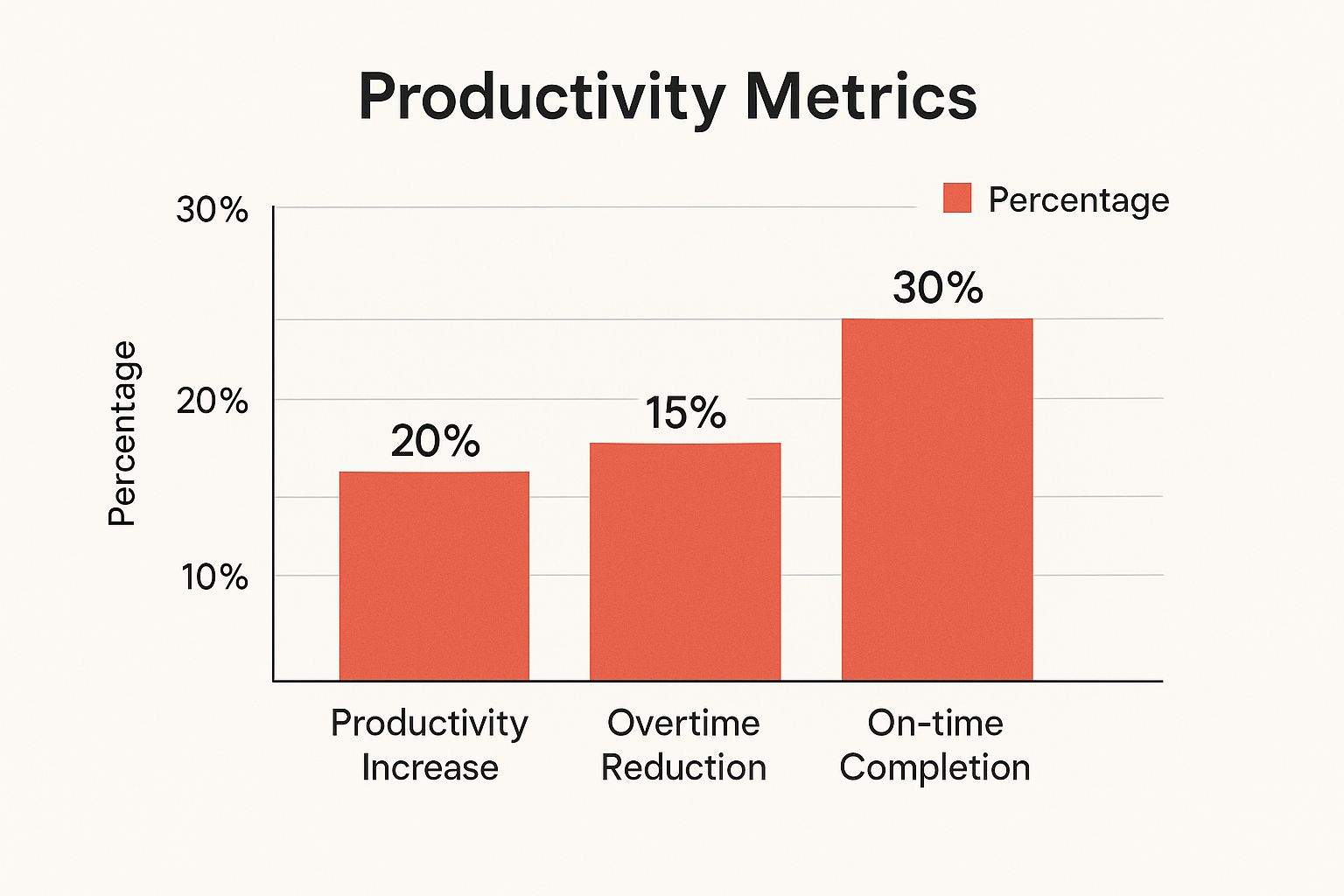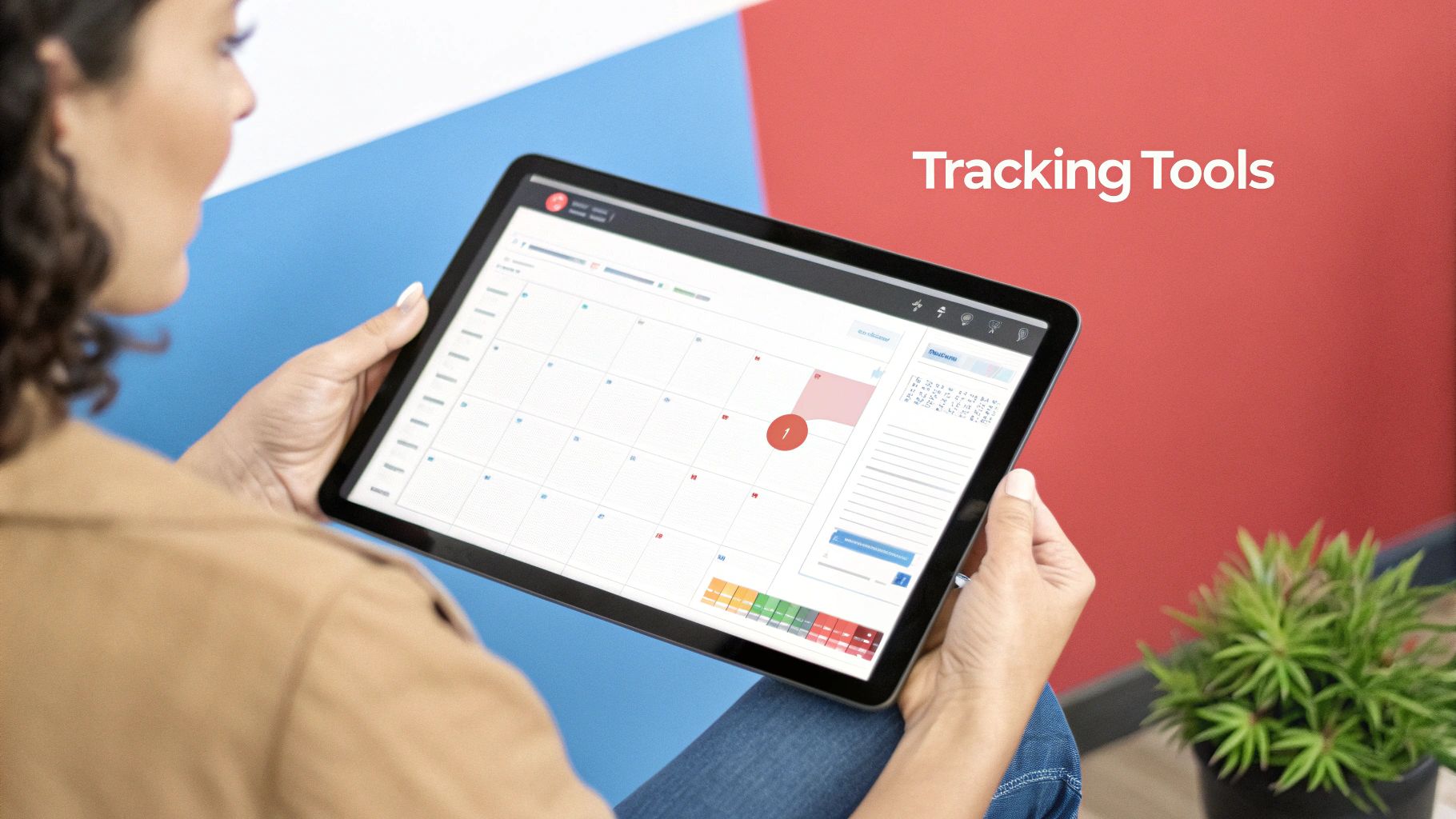Measuring team productivity in your agency isn't just about counting widgets or clocking hours. It’s about looking at the bigger picture: efficiency, quality, and the actual impact your team has on client goals and your bottom line. For agencies, this means it's time to finally move past tracking only billable hours and start assessing what really matters—client happiness, project profitability, and the well-being of your team.
True productivity is what happens when daily tasks directly lead to meaningful business outcomes.
Why Agencies Must Look Beyond Billable Hours

For decades, the billable hour was the unquestioned king of agency productivity. It's simple, it's easy to track, and it ties directly to revenue. But let's be real—it's a deeply flawed metric that tells a dangerously incomplete story.
Think about it. An employee who bills 40 hours a week isn't automatically more productive than someone who bills 30. What if those 40 hours were spent on endless revisions because of a communication breakdown, while the other person delivered a flawless campaign in less time? The billable hour actually rewards inefficiency. It measures presence, not performance.
A Modern Framework for Measuring Agency Productivity
To get a real handle on team productivity, the top-performing agencies are looking past raw output. They're zeroed in on the outcomes that actually drive growth. This modern approach redefines what "productive" even means for different roles, whether it's creative, marketing, development, or client services.
This shift calls for a new, more balanced framework. Instead of just asking, "How many hours did we log?" the better questions for your agency are:
- Did our work delight the client? This is where you look at things like client satisfaction scores, Net Promoter Score (NPS), and how many positive reviews or referrals you're getting.
- Was this project profitable? This ties team effort straight to the bottom line, analyzing profit margins that go way beyond just the time billed.
- How efficient was our process? Here, you're digging into internal metrics like task turnaround time and the number of revision cycles a project required.
- Is our team engaged and growing? This is all about employee well-being, skill development, and retention rates—all critical for long-term agency success.
By focusing on outcomes over hours, you build a culture that celebrates efficiency, innovation, and client success. This doesn't just give you a more accurate picture of performance; it also boosts morale by showing your team the real-world impact of their work.
This approach turns productivity from a tedious time-tracking exercise into a powerful strategic tool. It helps you spot workflow bottlenecks, identify your most profitable clients, and truly understand where your team shines. It sets the foundation for a measurement system that connects your team’s daily grind directly to agency growth and client loyalty.
Selecting Productivity Metrics That Actually Matter for Your Agency
Drowning in data is just as bad as having none. To get a real handle on team productivity, your agency has to look past vanity metrics and zero in on Key Performance Indicators (KPIs) that actually tell you something useful. The goal isn't just to track stuff; it's to choose a balanced set of metrics that tell the complete story of your team's performance, not just one chapter.
This means digging deeper than project completion rates. A truly insightful approach organizes metrics across four critical areas of your agency's health. This way, you're not just tracking output, but the real impact your team has on clients, financials, operations, and each other.
The Four Pillars of Agency Performance Metrics
A balanced scorecard for any agency should always mix qualitative and quantitative data. If you focus only on one area, like financial health, you're setting yourself up for team burnout and unhappy clients.
Instead, pick a few powerful KPIs from each of these core pillars:
Client Success Metrics
This is all about measuring the quality and impact of your work from the most important perspective: your client's. Think beyond just hitting deadlines and focus on their actual satisfaction.
- Client Satisfaction (CSAT) Scores: This gives you a direct pulse on how happy clients are with specific deliverables or project phases.
- Milestone Velocity: This tracks how quickly your team moves through key project stages, which is a great indicator of both efficiency and how well you're aligned with client expectations.
Financial Health Metrics
These are the metrics that connect your team's day-to-day efforts directly to the bottom line. No fluff here.
- Project Profitability: It's the ultimate measure of financial success for any agency project. After all costs are accounted for, did the project actually make money?
- Revenue Per Employee: This is a high-level indicator of your agency's overall financial efficiency and a great number to track over time.
Operational Excellence and Team Well-being Metrics
While keeping clients happy and the lights on are crucial, how you get the work done matters just as much. This is where operational metrics come in. They help you spot and eliminate the internal friction that’s secretly killing productivity.
The biggest measurement gap isn't in tracking what people do, but in capturing the true value they create. Focusing on the right metrics helps bridge this gap, turning abstract effort into tangible results.
Just as important is the health of your team. A burned-out, disengaged team simply can't deliver great work, making well-being a leading indicator of future productivity.
Operational Excellence
- Resource Utilization Rate: This shows how much of your team's available time is spent on billable client work versus internal tasks. It's a classic for a reason in the agency world.
- Task Turnaround Time: This measures the average time it takes to complete specific, repeatable tasks—a great way to spot bottlenecks.
Team Well-being
- Employee Engagement Scores: This assesses team morale and how connected people feel to the agency's mission.
- Skill Progression: Are your team members learning and growing? Tracking skill development is key to building future capabilities.
This balanced approach isn't just a nice idea; it's becoming a business imperative. A recent global survey found that 74% of organizations feel it's critically important to find better ways to assess worker performance. Yet, only a startling 17% believe they are effective at it. That massive gap signals a clear need for a more holistic strategy. You can read the full research on new ways to measure productivity to see how the industry is shifting.
To help you get started, here's a breakdown of key metrics across different agency functions. This should give you a solid foundation for choosing the most relevant KPIs for your teams.
Essential Productivity Metrics for Agency Teams
Picking from a list like this ensures you're not just measuring busyness, but actual effectiveness across the entire agency.
The chart below shows what happens when you start focusing on the right things—you get measurable improvements where it counts.

As you can see, a strategic focus on productivity doesn't just push project completion rates up; it also leads to welcome reductions in costly overtime and delivers a solid boost in overall output.
How to Build Your Agency's Productivity Tech Stack

Alright, you've defined your metrics. Now comes the part that trips up a lot of agencies: actually collecting the data without it turning into another full-time job. This is where your tech stack comes in.
The goal isn't just to buy a bunch of fancy software. It's to build an integrated system where data flows automatically, giving you a single source of truth for your agency's performance. No more manual data entry. No more chasing down timesheets.
The biggest mistake I see is creating a siloed tech stack. When your project management tool doesn't talk to your time intelligence software, you're creating more problems than you solve. It forces your team to enter the same info in multiple places and leaves agency leadership guessing what’s really happening.
Core Components of an Integrated Agency Tech Stack
For a modern agency, a solid productivity tech stack usually hangs on a few key pillars. Each piece serves a specific purpose, from handling the daily grind to capturing those big-picture strategic insights.
Project Management Platforms: This is the operational heart of your agency. Think tools like Asana, Jira, or ClickUp. They organize workflows, dish out tasks, and track how projects are moving against deadlines. This is where you get foundational data on things like task completion rates and milestone velocity.
Time Intelligence Software: This goes way beyond basic time tracking. These tools give you the real story of how time is spent. They can automatically categorize work, show you how much time is spent on focused tasks versus admin fluff, and help you calculate project profitability with scary accuracy.
Communication Hubs: This is where the magic happens—platforms like Slack or Microsoft Teams. Integrating them properly means important decisions and files get linked back to specific projects, which drastically cuts down on the "Where did we talk about that?" chaos.
The best tech stacks aren't just a shopping list of good tools; they're an interconnected ecosystem. Always prioritize software with robust integrations. You want a seamless data pipeline from the moment a task is assigned to the final report.
How to Evaluate New Tools for Your Agency
Picking the right software isn't about finding the "best" tool—it's about finding the right tool for your agency. A solution that’s perfect for a massive development firm will be total overkill for a boutique creative shop.
As you start looking at options, you need a clear evaluation process. Here's a simple checklist to keep you focused on what actually matters.
Software Evaluation Checklist for Agencies
- Integration Power: Does it play nicely with the other tools you already use? Look for native integrations with your CRM, project management platform, and communication hub. If it doesn't connect, it doesn't belong.
- Reporting Depth: Can you pull the specific reports you need to track the KPIs you just defined? Stay away from tools with rigid, one-size-fits-all dashboards. You need customizable reporting that matches your unique metrics.
- Team Adoption Potential: Let's be real—is the interface intuitive? A powerful tool is completely useless if your team finds it too clunky and just… doesn't use it.
To get the most out of your tools, you also need to nail down your processes. That includes tackling the productivity black hole that is the team inbox. Thinking through things like mastering team email management for peak productivity ensures that even your communication habits are helping, not hurting, your efficiency goals.
How to Turn Raw Data Into Actionable Agency Insights

Collecting data is one thing; turning those numbers into a story about your agency's performance is where the real value lies. Raw metrics are just noise until you connect the dots and translate them into clear insights that tell you what to do next.
This is exactly where many agencies get tripped up. They're sitting on a mountain of data but can't seem to find the narrative within it. The trick is to stop just reporting numbers and start asking why they look the way they do.
Let's say you see a sudden dip in your Task Turnaround Time. That's a signal. Was it a one-off hit from an unusually complex project, or does it point to something bigger, like an under-resourced department or a clunky workflow? To get that answer, you have to look at related data points.
Connecting Data for a Holistic View of Agency Performance
Looking at metrics in isolation gives you a fractured picture of reality. The most powerful insights pop up when you start connecting data from different parts of your agency to understand cause and effect. This is how you measure productivity in a way that actually matters.
Start by asking questions that bridge the gap between your operational data and your financial outcomes:
- How did a 10% increase in resource utilization for the design team impact the profitability of our last three projects?
- Is there a connection between low client satisfaction scores and projects that needed more than two rounds of revisions?
- Do teams with higher engagement scores also have lower turnover and better project margins?
This kind of thinking helps you diagnose problems with real precision. Instead of just knowing project profitability is down, you might discover it’s because of scope creep in the development phase, which is blowing up your timelines and eating your margin alive.
Data analysis isn't about finding someone to blame; it's about finding processes to fix. The goal is to build a culture where data shines a light on challenges and celebrates wins, empowering everyone to help make things better.
This analytical mindset is more important than ever. Globally, productivity growth has slowed to a crawl. Data from the OECD shows that growth across 40 developed countries was a tiny +0.4%, a massive drop from the pre-pandemic average of 1.8% per year. This is exactly why generic benchmarks don't work and why agencies must dig into their own unique data to find their path forward. You can learn more about these global productivity trends on archieapp.co.
From Analysis to Actionable Dashboards for Agency Leaders
Once you’ve found these connections, the last piece of the puzzle is presenting them in a way your leadership team can quickly understand and act on. That means building clean, concise dashboards and reports.
Forget overwhelming spreadsheets with endless rows of numbers. A good dashboard tells a story at a glance. It should spotlight your main KPIs, show trends over time, and immediately draw your eye to any metrics that are off-target.
For any busy agency leader, your dashboard needs to answer three questions instantly:
- Where are we winning? Highlight what's going well to reinforce positive behaviors and strategies.
- Where are the risks? Use simple color-coding (like red, yellow, green) to flag areas needing attention.
- What should we do next? Add brief notes or recommendations right next to the data.
By turning raw numbers into a clear story, you give your leadership team the tools to make smarter, data-informed decisions that fuel real agency growth.
Using Data to Foster a Culture of Continuous Improvement
How you share your findings from productivity data will either spark growth or create a culture of anxiety. It's a fine line to walk. Once you've dug into the numbers, the final—and most important—step is to use what you've learned to build your team up, not tear them down. This is where you pivot from being a manager to being a mentor, turning cold, hard data into a shared tool for success.
For anyone leading a team, especially in an agency setting, this means framing these conversations as opportunities to collaborate, not criticize. The end game is to build a transparent culture where metrics are seen for what they are: a way to spot cracks in the process, not flaws in the people.
How to Frame Conversations Around Growth and Support
When you sit down with your team, always lead with curiosity. It makes all the difference.
Instead of hitting them with, "Your team's project profitability is down," try opening the door with a question like, "I noticed our margins on the last few projects were tight. What roadblocks are you all running into that we can help clear?"
This simple shift in approach changes the entire dynamic. It immediately positions you as a supportive leader looking to solve problems with them, not just point them out. The data becomes the starting point for a real, constructive dialogue about what’s working and what isn’t.
When data is presented as a tool for collective improvement, it stops feeling like micromanagement and starts feeling like a compass. It helps everyone see how their work contributes to the bigger picture, empowering them to take ownership of agency goals.
Focusing on the process is absolutely critical. Think about it: workplace studies have shown that employees can spend a staggering 60% of their time on "work about work"—things like hunting for information, chasing approvals, or just switching between a dozen different apps. You can get more insights on how 'work about work' impacts productivity on proofhub.com. By using data to pinpoint these efficiency drains, you can genuinely make everyone's job easier and more impactful.
Celebrating Wins and Identifying Skill Gaps with Data
Data isn’t just for finding problems; it’s one of the best tools you have for celebrating success. When a team absolutely crushes its client satisfaction targets or shaves a day off its average task turnaround time, make that a public win.
Share the numbers in team meetings. Highlight exactly what they did differently to achieve it. This kind of positive reinforcement shows the team you’re paying attention to their hard work and that the metrics are there to validate their efforts, not just scrutinize them.
At the same time, data can gently point toward areas that need a bit more support. If you notice a team is consistently getting bogged down by scope creep, it might not be an issue of effort but a sign they need better training. Maybe they need more guidance on client communication or project scoping.
Similarly, if tasks are piling up because delegation is a recurring bottleneck, it might be time to revisit how you hand off work. We've got a whole guide on how to delegate tasks effectively that can help with that.
Use these insights to offer targeted training, workshops, or resources. This shows you're committed to your team's professional development, turning a potential negative into a clear path for growth. It proves you're invested in their success, which is the cornerstone of any thriving, high-performing team.
Frequently Asked Questions About Agency Productivity
Switching up how you measure team productivity always brings a few key questions to the surface. As an agency leader, you want a system that's fair and effective—not something that just creates more headaches.
Let's dive into some of the most common concerns I hear from other leaders.
How do you measure the productivity of creative roles in an agency?
This is the classic dilemma. Creative work isn't like stamping out widgets on an assembly line. For your designers, writers, and strategists, you have to shift the focus from input (hours logged) to impact and quality. Trying to clock creativity is a game you'll never win.
Instead, look at metrics that actually tell you something meaningful about their agency contribution:
- Client Satisfaction Scores: How do clients feel about the work they’re getting? High scores are a dead giveaway that your team is delivering quality.
- Revision Rounds: Keep an eye on the average number of revisions a project needs. Fewer rounds usually mean the initial concept was stronger and better aligned from the get-go.
- Campaign Performance: This is the ultimate test. How did the creative work perform in the real world? Look at engagement rates, conversion lift, or brand sentiment.
You also can't forget about qualitative feedback from clients and internal team members. It’s the only way to really gauge things like innovation and collaboration.
The goal is to measure the effectiveness of the output, not the effort behind it. A brilliant idea that takes two hours is always going to be more valuable than a mediocre one that took ten.
Will tracking productivity make my agency team feel micromanaged?
It's a valid fear, and one that's completely avoidable. That feeling of being watched usually comes from a lack of transparency and a missing "why." If your team thinks you’re just counting clicks, they’re going to tune out. But when you frame productivity data as a tool for making their lives easier, everything changes.
It all comes down to how you introduce and use the data.
- Involve Your Team: Don't just hand down metrics from on high. Ask for their input. This creates ownership and ensures the KPIs actually make sense for their day-to-day work.
- Focus on Process, Not People: Use the data to spot bottlenecks in your systems, not to call out individuals. Frame it as, "How can we make this process smoother for everyone?"
- Celebrate Wins: When the numbers look good, shout it from the rooftops. When data is used to praise great work, it stops being scary and starts being a motivator.
When your team sees the goal is to remove friction and help them succeed, data goes from being a threat to a trusted ally.
How often should we review our agency's productivity metrics?
Finding the right rhythm for reviews is crucial. You want the data to be actionable, but you don't want to drown your team in meetings. There's no one-size-fits-all answer; it has to match the pace of your agency.
Here’s a good starting point for most agencies:
- Weekly or Bi-Weekly Check-Ins: These are perfect for looking at project-level data. You can tackle immediate roadblocks, clear up confusion, and make sure everything stays on track.
- Quarterly Strategic Reviews: Use these meetings for the big picture. This is where you zoom out and analyze your core agency KPIs. Are you still measuring what matters? Is everything still aligned with your business goals?
Agency priorities are always shifting, and your measurement framework has to be nimble enough to keep up. Regular reviews ensure your metrics stay relevant and continue to be a powerful tool for growth.




